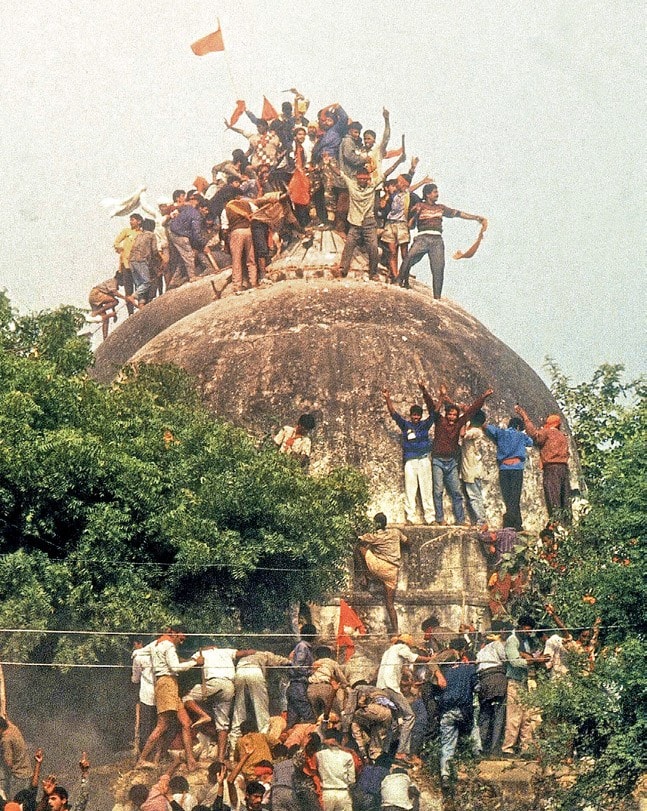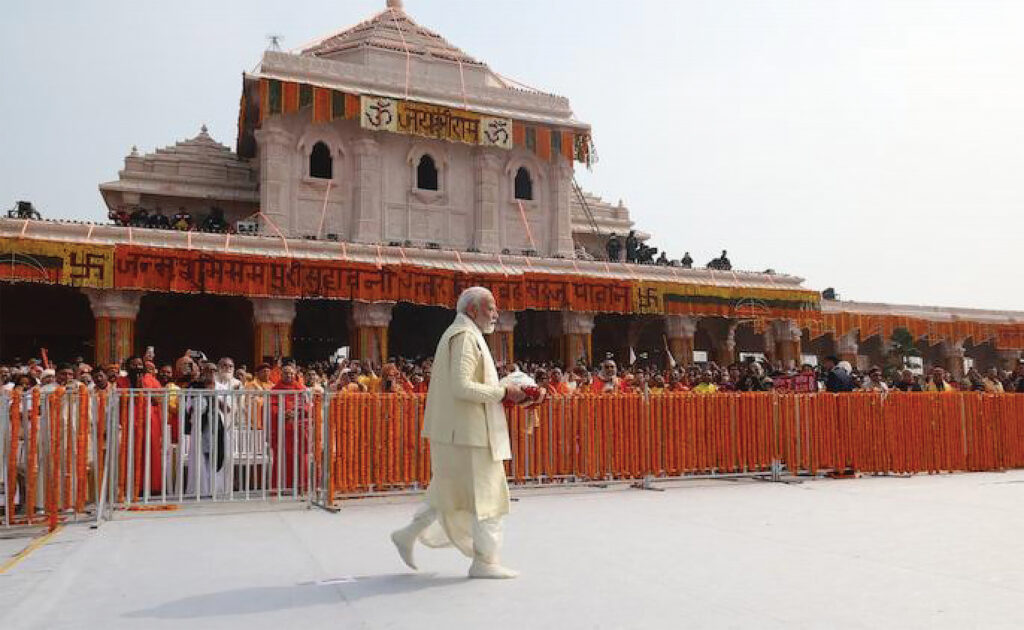The Symbol of Hindutva Terrorism
By Dr. Aslam Abdullah
Mar/Apr 2024

On January 22, Prime Minister Narendra Modi proudly inaugurated the Ram Mandir (temple) to great fanfare.
Historians generally don’t believe that the Hindu deity Ram really existed, yet there are 300 versions of his story. Many devotees call him the seventh incarnation of Vishnu, yet credit him for killing a shudra (Hinduism’s lowest caste) for learning Brahmanical scriptures and performing religious rituals.
Ram is a Brahmin-controlled god with no will or power of his own. The story says that when he was ruling Ayodhya, a Brahmin approached the court and told everyone that his young son had died due to Ram’s misrule. Ram immediately called a meeting of all his ministers and inquired about the cause. Sage Narada told him this had happened because a shudra named Shambuka was performing tapas (a voluntarily ascetic practice to achieve spiritual power or purification), which was denied in the age of Treta (Treta Yuga, which Hindus claim, lasted for 1,296,000 years, as life expectancy was gradually reduced to 1,000 years).
After finding Shambuka and confirming his lowest-caste status, Rama killed him. The gods then praised and congratulated him for protecting their interests and not allowing a shudra to attain heaven in person. The Brahmin’s son even got a new life.
Stories abound about Ram’s character as an ideal husband; however, based upon the Hindu scriptures, most Hindus believe Ram expelled Mata Sita (Mother Sita) from the royal palace because Ayodhya’s people had severe concerns about her fidelity, given that she had remained near Ravana for so many months. Poet Goswami Tulsidas’ version denies her abduction. In “Ram Charit Manas,” an epic poem based on the “Ramayana,” Ravana abducted her clone.
Another contradiction exists in Valmiki and Tulsidas’ versions about Hanuman’s nature. Maharishi Valmiki calls him a monkey; Tulsidas describes him as a human. He destroyed Sri Lanka by burning it down. But historically, no such fire burned the town of Ravan and there are no fossils to prove that it ever existed.
Competing Claims and Agendas
Based on unproven stories, Hindu nationalists have constructed a version of theology that defies reason. They have brainwashed generation after generation, causing one of the biggest frauds in religious history.
Many call Ram the most benevolent character, yet his devotees tore down the 650 year old Babri Masjid in Ayodhya, which they claimed was his birthplace.
Ram’s followers give 5114 BCE as his birth year. Valmiki wrote his story in 300 BCE in Sanskrit, claiming to have met him. Legend says that Ram ruled for 11,000 years. Based on his birth year and his reign dates, he may still be alive overseeing the destruction of the Babri Masjid on Dec. 6, 1992, and directing India’s Supreme Court in its decision on Nov. 9, 2019, to give Ram Lalla (Infant Lord Rama) the land’s possession.
What a way to celebrate a deity claiming to own the universe after making it!
Hindu nationalists claim that the plot of land on which Babri Masjid sat was Rama’s birthplace, which is another myth perpetuated by devotees. Many historians state that such claims sprang up only after the 18th century. Ayodhya emerged as a place of Hindu pilgrimage only in medieval times, since ancient texts do not mention it as such. For example, chapter 85 of the “Vishnu Smriti,” one of the latest books of Hinduism Dharmaśāstra tradition, lists 52 places of pilgrimage. Ayodhya isn’t one of them.

Many also claim that present-day Ayodhya was originally a Buddhist site, based on its identification with Saketa, a Sanskrit appellation of the city of Ayodhya found in Buddhist texts. According to historian Romila Thapar, ignoring the mythological accounts, the city’s first historical mention dates to the 7th century, when the Chinese pilgrim Xuanzang described it as a Buddhist site (Romila Thapar, ed. “Cultural Pasts: Essays in Early Indian History,” 2000).
Hindu fascists use this religious myth to mobilize Hindus against Islam and Muslims. They have weaponized Ram to fan hatred and reassert upper caste hegemony.
None of the four shankaracharyas, the religious leaders who head the four monasteries founded by Adi Shankara (c.500-c.550) according to the Advaita Vedanta tradition, attended the temple’s inauguration. These men are among Hinduism’s foremost spiritual authorities. According to Prime Asia News (Jan. 11; www.asianews.it/) none of them spoke against the mosque’s demolition.
No historical account proves that Muslims demolished an existing temple to build a mosque. The claim that this was Ram’s birthplace is false. There is no record of a temple built by Ram’s devotees where the present temple stands.
Do Hindu nationalists intend to use the temple for electoral purposes? Many would believe so, thinking that anti-Islam electoral politics will win them elections and unite Hindus divided among their 33 million deities and thousands of castes (a figure cited by Yagyavalkya, a Hindu Vedic sage, www.pandeymarblearts.com/).
The nationalists want to build an India full of hatred and animosity against Islam, Christianity, Buddhism and Sikhism to give legitimacy to a structured system of inequality. India is controlled by a caste — the Brahmins — that believes in its superiority.
The temple is a symbol of Hindutva terror and violence. Its existence should always remind all religious people of the Hindu fascists’ tyranny. It uses scriptures to justify the division. As long as castes exist, Hinduism will remain a fascist ideology. The Ayodhya temple is a living testimony of Hindutva’s promotion of human inequality.
Events Leading to the Current Status Quo
During the 1980s, the Vishva Hindu Parishad (VHP) began a campaign to construct a temple dedicated to Ram at the site, with the now ruling Bhartiya Janata Party (BJP) as its political voice. On Dec. 6, 1992, they organized a rally of 150,000 Hindus. The rally turned violent, and the crowd overwhelmed the deployed security forces and destroyed the mosque. A subsequent inquiry found 68 people responsible, including several BJP and VHP leaders.
For at least four centuries, the site was used for religious purposes by both Hindus and Muslims. The claim that it stood on the site of a former temple was first made in 1822 by a Faizabad court official. The Nirmohi Akhara sect cited this statement while laying claim to the site during the 19th century, which led to the first recorded incidents of religious violence there in 1855. In 1859, the British colonial administration erected a railing to separate the mosque’s outer courtyard to avoid disputes.
This status quo remained in place until 1949, when Hindu Mahasabha activists allegedly placed idols of Rama secretly inside the mosque. This caused an uproar, with both parties filing civil suits laying claim to the land. The idols’ placement was seen as a heresy by the mosque’s users. The site was declared to be in dispute, and the gates to the mosque were locked.
During the 1980s, the VHP began a campaign to construct a temple dedicated to Rama at the site. The movement was bolstered by the decision of a district judge who, in 1986, ruled that the gates would be reopened and Hindus permitted to worship there. Indian National Congress politician Rajiv Gandhi, at that time India’s prime minister, endorsed this decision.
In September 1990, BJP leader L. K. Advani began a rath yatra, a political rally traveling across much of northern India to Ayodhya, to generate support for the proposed temple and unite Hindu votes by mobilizing anti-Muslim sentiment. The Bihar state government arrested him before he could reach his destination. But despite this, a large body of Sangh Parivar supporters reached the site and attempted to attack the mosque.
The ensuing pitched battle with the paramilitary forces ended with the death of several rioters. The BJP withdrew its support of V. P. Singh’s ministry necessitated fresh elections during which it substantially increased its tally in Parliament and won a majority in the Uttar Pradesh assembly.
On Dec. 6, 1992, the RSS and its affiliates organized a rally of 150,000 VHP and BJP supporters at the site. The ceremonies included speeches by BJP leaders such as Lal Krishna Advani, Murli Manohar Joshi and Uma Bharti. During the rally’s first few hours, the crowd grew increasingly restless and began chanting slogans. Around noon, a young man slipped past the cordon and climbed the mosque brandishing a saffron flag. Seeing this as a signal, the mob overwhelmed the police cordon — the vastly outnumbered police fled. Using axes, hammers and grappling hooks, within a few hours the mob leveled the mud-and-chalk structure.
The then Prime Minister P. V. Narasimha Rao has often been criticized for mishandling the situation. In his book “Ayodhya December 6, 1992,” he wrote that the demolition was a “betrayal” by Kalyan Singh, the then chief minister of Uttar Pradesh, who repeatedly assured the Congress government that the mosque would be protected.
In his March 2005 book, “Open Secrets: India’s Intelligence Unveiled,” former Intelligence Bureau head Maloy Krishna Dhar claimed that the Rashtriya Swayamsevak Sangh (RSS), BJP and VHP’s top leaders had planned the demolition for 10 months and criticized how Rao had handled the situation.
Dhar also claimed that he was told to arrange security for a meeting between individuals from the BJP and other constituents of the Sangh Parivar and that the meeting “proved beyond doubt that they (RSS, BJP, VHP) had drawn up the blueprint of the Hindutva assault in the coming months and choreographed the pralaya nritya (dance of apocalypse) at Ayodhya in December 1992.”
The RSS, BJP, VHP and the Bajrang Dal leaders present agreed to work in a well-orchestrated manner. Claiming that he personally handed over the meeting tapes to his boss, Dhar asserts that he has no doubts that his boss had shared their contents with Rao and Home Minister Shankarrao Chavan. The author further claims that there was a silent agreement that Ayodhya offered “a unique opportunity to take the Hindutva wave to the peak for deriving political benefit.”
In April 2014, a sting operation by Cobrapost claimed that the demolition was not an act of a frenzied mob, but sabotage planned with so much secrecy that no government agency got wind of it. It further said that VHP and Vjv Sena drew the plan, which later, the BJP government and the Courts would adopt.
Dr. Aslam Abdullah, editor-in-chief of Muslim Media Network, is a resident Islamic scholar and former imam.
Tell us what you thought by joining our Facebook community. You can also send comments and story pitches to horizons@isna.net. Islamic Horizons does not publish unsolicited material.
